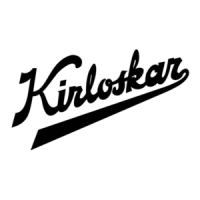Do you have a question about the KIRLOSKAR UP 80/30 and is the answer not in the manual?
Defines pump naming conventions and component descriptions.
Provides overarching safety principles and hazard awareness.
Guidelines for safe transport, handling, and storage of the pump.
Procedures for inspecting the pump upon delivery for damage.
Steps to prepare the pump and site before installation.
Recommendations for optimal pump placement for performance.
Requirements for a stable and rigid foundation for the pump.
Steps for leveling and positioning the pump baseplate.
Method for securing the baseplate to the foundation with grout.
Steps to ensure proper alignment between pump and driver shafts.
Guidelines for connecting suction and discharge pipework correctly.
Pre-operation checks to ensure the pump is ready for startup.
Step-by-step guide for starting the pump safely.
Monitoring and checks during pump operation.
Procedure for safely shutting down the pump.
Specifies the standard and optional directions of pump rotation.
Information on bearing models and types used in the pumps.
Instructions for proper handling and maintenance of bearings.
Guidance on initial lubrication and re-greasing intervals.
Specifications for diametrical clearances of casing wear rings.
Information on single and double entry impeller types.
Information on packing and mechanical seal arrangements.
Types of couplings supplied or available for the pumps.
Recommended minimum flow rate to prevent pump damage.
Requirements for Net Positive Suction Head for satisfactory operation.
Recommended flow velocities for suction and delivery pipes.
Sizes and types of tapping connections on the pump.
Maximum forces and moments the pump flanges can withstand.
Nominal bore sizes for pump suction and delivery connections.
Data on maximum operating speed and pump fill capacity.
Information on torque required for starting the pump.
Approximate net weights and rotational inertia of pump models.
Details on which pump components are interchangeable.
Safety guidelines related to environmental, health, and safety during maintenance.
A schedule of periodic checks and maintenance tasks.
Step-by-step instructions for disassembling the pump.
Step-by-step instructions for reassembling the pump.
Describes angular and parallel misalignments between shafts.
Process for leveling the pump and driver assembly on the baseplate.
Procedures for checking and adjusting flexible coupling alignment.
A guide to diagnose pump issues based on symptoms and check points.
Safety precautions for handling, storage, and general use.
Safety measures for pump assembly and installation procedures.
Safety guidelines during pump commissioning and initial operation.
Safety protocols for performing maintenance and servicing tasks.
Defines pump naming conventions and component descriptions.
Provides overarching safety principles and hazard awareness.
Guidelines for safe transport, handling, and storage of the pump.
Procedures for inspecting the pump upon delivery for damage.
Steps to prepare the pump and site before installation.
Recommendations for optimal pump placement for performance.
Requirements for a stable and rigid foundation for the pump.
Steps for leveling and positioning the pump baseplate.
Method for securing the baseplate to the foundation with grout.
Steps to ensure proper alignment between pump and driver shafts.
Guidelines for connecting suction and discharge pipework correctly.
Pre-operation checks to ensure the pump is ready for startup.
Step-by-step guide for starting the pump safely.
Monitoring and checks during pump operation.
Procedure for safely shutting down the pump.
Specifies the standard and optional directions of pump rotation.
Information on bearing models and types used in the pumps.
Instructions for proper handling and maintenance of bearings.
Guidance on initial lubrication and re-greasing intervals.
Specifications for diametrical clearances of casing wear rings.
Information on single and double entry impeller types.
Information on packing and mechanical seal arrangements.
Types of couplings supplied or available for the pumps.
Recommended minimum flow rate to prevent pump damage.
Requirements for Net Positive Suction Head for satisfactory operation.
Recommended flow velocities for suction and delivery pipes.
Sizes and types of tapping connections on the pump.
Maximum forces and moments the pump flanges can withstand.
Nominal bore sizes for pump suction and delivery connections.
Data on maximum operating speed and pump fill capacity.
Information on torque required for starting the pump.
Approximate net weights and rotational inertia of pump models.
Details on which pump components are interchangeable.
Safety guidelines related to environmental, health, and safety during maintenance.
A schedule of periodic checks and maintenance tasks.
Step-by-step instructions for disassembling the pump.
Step-by-step instructions for reassembling the pump.
Describes angular and parallel misalignments between shafts.
Process for leveling the pump and driver assembly on the baseplate.
Procedures for checking and adjusting flexible coupling alignment.
A guide to diagnose pump issues based on symptoms and check points.
Safety precautions for handling, storage, and general use.
Safety measures for pump assembly and installation procedures.
Safety guidelines during pump commissioning and initial operation.
Safety protocols for performing maintenance and servicing tasks.
| Model | UP 80/30 |
|---|---|
| Voltage | 415 V |
| Frequency | 50 Hz |
| Material | Cast Iron |
| Flow Rate/Discharge | 80 m³/hr |
| Head | 30 meters |
| Phase | Three Phase |











